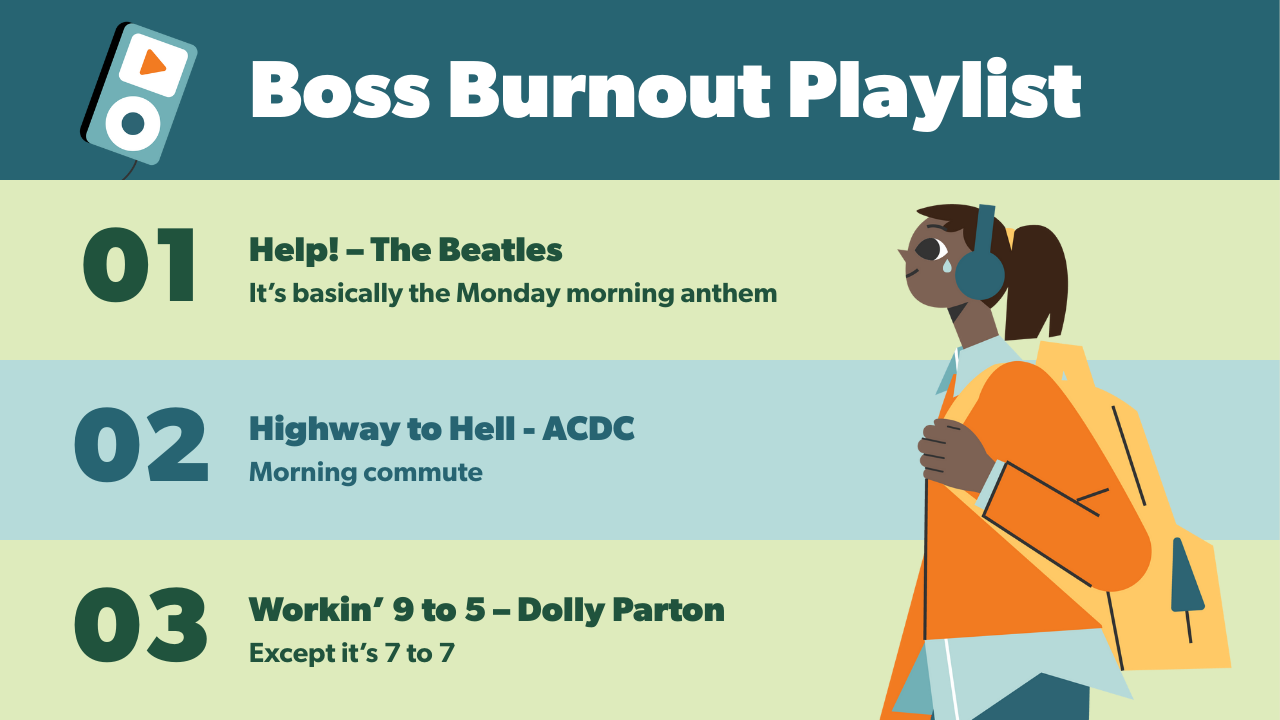
Burnout: Now Available in Executive Size
Aug 22
/
Hannelie Pretorius

It’s 9:47 pm. Your CEO is reviewing tomorrow’s board pack. Your middle manager is still online, double-checking that a project handover is airtight. Both are tired. Both are carrying lists in their heads: People, performance, priorities… and the things they’ve quietly sacrificed that day to keep the wheels turning.
From the outside, they might seem worlds apart. One sets the vision; the other delivers it. But in reality, they’re both people under pressure, shouldering the weight of expectations from all directions.
From the outside, they might seem worlds apart. One sets the vision; the other delivers it. But in reality, they’re both people under pressure, shouldering the weight of expectations from all directions.
The Invisible Load of Leadership - From Top Floor to Team Floor
We talk about employee burnout often. And we should. But burnout in leadership roles both at the C-suite and middle management levels is often invisible.
For a CEO, the load might look like:
For a middle manager, it’s:
The scale is different, but the strain is real for both.
- 53% of managers report feeling burned out (HBR/Microsoft Work Trend Index).
- Over 50% of managers say sustained stress impacts their performance (The Wellbeing Project).
- Manager engagement has fallen from 30% to 27% in just one year, costing billions in productivity (Business Insider/Gallup).
For a CEO, the load might look like:
- Balancing shareholder expectations with long-term organisational health.
- Making high-stakes calls with incomplete information.
- Carrying the emotional climate of an entire company. For example; morale dips, culture shifts and change fatigue
- Projecting confidence, even when the path forward is uncertain.
For a middle manager, it’s:
- Translating big-picture strategy into doable actions for their team.
- Shielding employees from the worst of top-down pressure.
- Managing competing demands from above, below, and across.
- Feeling like the “accountability postbox” for every decision.
The scale is different, but the strain is real for both.
Middle Management: The Post-box Nobody Talks About
"Middle managers are the glue holding the organisation together, and sometimes, the gum stuck under its desk."
Middle managers are the translators, buffers, and couriers of organisational life. They’re accountable to the CEO, their peers, their teams, and often customers all at once.
This constant crossfire creates role conflict:
Without proper support, this can lead to emotional exhaustion, cynicism, and disengagement not just for the manager, but for the teams relying on them.
Middle managers are the translators, buffers, and couriers of organisational life. They’re accountable to the CEO, their peers, their teams, and often customers all at once.
This constant crossfire creates role conflict:
- Being pulled in opposing directions daily.
- Having to enforce policies they didn’t make and don’t fully agree with.
- Carrying the emotional weight of both corporate decisions and individual team struggles.
Without proper support, this can lead to emotional exhaustion, cynicism, and disengagement not just for the manager, but for the teams relying on them.
Your CEO is Not a Superhero (And Neither is Your Manager)
We romanticise the “invincible leader” the CEO who never flinches, the manager who always has the answers. The truth? Both are human.
A CEO might spend a sleepless night worrying about job cuts or the impact of a bad quarter on staff livelihoods. A middle manager might drive home wondering how to motivate a burnt-out team without losing themselves in the process.
The myth of invincibility forces silence. Leaders feel they can’t ask for help, and the empathy gap grows wider. That silence has consequences: slower decision-making, lower morale, and disengaged teams.
A CEO might spend a sleepless night worrying about job cuts or the impact of a bad quarter on staff livelihoods. A middle manager might drive home wondering how to motivate a burnt-out team without losing themselves in the process.
The myth of invincibility forces silence. Leaders feel they can’t ask for help, and the empathy gap grows wider. That silence has consequences: slower decision-making, lower morale, and disengaged teams.
The Empathy Gap & Why Leading Up Matters
In a study of 51,896 executives, Zenger Folkman found that leaders who actively seek feedback rank far higher in effectiveness top 10% feedback-seekers place at the 86th percentile, while bottom 10% languish at the 15th percentile (Zenger Folkman).
Yet both CEOs and middle managers often work in a feedback vacuum. People hesitate to “lead up” out of fear, deference, or habit. Without upward support, even the best leaders can make missteps that affect the whole organisation.
Yet both CEOs and middle managers often work in a feedback vacuum. People hesitate to “lead up” out of fear, deference, or habit. Without upward support, even the best leaders can make missteps that affect the whole organisation.
How to Lead Up - No Matter Who’s Above You
To your CEO:
To your middle manager:
Leading up isn’t about undermining, it’s about making leadership a shared responsibility.
- Share insights from the ground market changes, customer feedback, employee sentiment.
- Offer solutions alongside challenges.
- Recognise their wins publicly; they often hear criticism far more than praise.
To your middle manager:
- Check in personally: “How are you holding up?”
- Offer constructive, actionable feedback.
- Take ownership where you can to lighten their load.
Leading up isn’t about undermining, it’s about making leadership a shared responsibility.
The Future of Leadership is Collective
Resilient organisations don’t happen because of heroic individuals they happen because of mutual support across every level. That means:
Because leadership is not a one-way street, it’s an infinite loop. The sooner we design for that, the stronger, more human, and more sustainable our workplaces will be.
Leading up, for example, might mean respectfully challenging your manager’s approach when you see a better way, sharing insights they might not have, or flagging risks they haven’t spotted in other words, helping them succeed so the whole team can.
This way, you’re not assuming shared understanding, and you’re also subtly showing that it’s about mutual responsibility, not insubordination.
- CEOs being honest about their limits.
- Middle managers are being recognised and resourced for their post-box role.
- Teams practising upward empathy as much as downward.
Because leadership is not a one-way street, it’s an infinite loop. The sooner we design for that, the stronger, more human, and more sustainable our workplaces will be.
Leading up, for example, might mean respectfully challenging your manager’s approach when you see a better way, sharing insights they might not have, or flagging risks they haven’t spotted in other words, helping them succeed so the whole team can.
This way, you’re not assuming shared understanding, and you’re also subtly showing that it’s about mutual responsibility, not insubordination.
Resources
-
https://hbr.org/2023/05/more-than-50-of-managers-feel-burned-out
-
https://thewellbeingproject.co.uk/insight/manager-burnout/
-
https://www.businessinsider.com/manager-engagement-gallup-workplace-report-2025-4
-
https://www.ft.com/content/87f39dc8-bb16-44e5-b80e-724b1bae67b8
-
https://workplacewellbeing.pro/slider/disengagement-and-manager-burnout-damaging-uk-workplaces/
-
https://zengerfolkman.com/articles/a-leadership-tip-that-just-works-ask-for-feedback/
-
https://zengerfolkman.com/wp-content/uploads/2019/08/Feedback-the-Powerful-Paradox_WP-2019.pdf


